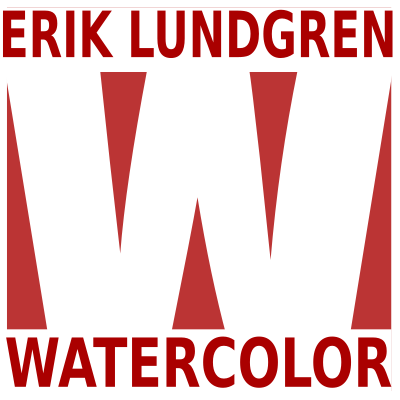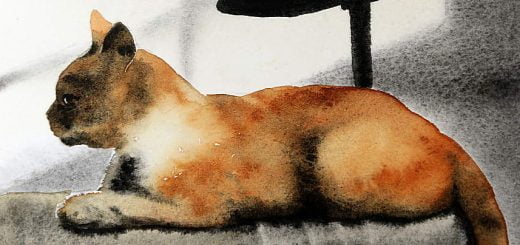Still life, wet on wet

This is an exercise in wet on wet technique. It is painted with cobalt blue, burnt sienna and raw sienna. If you miss these colors, you can use French ultramarine instead of cobalt blue, the raw sienna can be replaced with yellow ocher or other yellow-brown, the same with the burnt sienna that can be changed to another orange-brown color.

Step 1

Start, as usual, with the background. Paint with a mixture of all three colors, make the mixture grayish and dark, then dilute some of the paint with water so you have a few different values available. Paint the background down to the table surface and around the objects, really wet it should be so that a nice pattern occurs when the paint has dried. Use the different mixtures so that the surface does not become flat, but paint with different values in different places in the background. I made my background lightest on the right and darker on the left.
When the first surface has dried, the table surface on which the objects stand must be painted. Paint lighter than the background and preferably flat, if you want, before it has dried, you can add a little darker color on the left side.
Step 2

Now some shadows that the different objects cast on the background should be painted. Since there are two light sources, the shadows are double. If you think it’s too difficult or you do not like it, then ignore this and paint only one shadow per object. Use leftovers you have from the background for this, if you have no paint left, mix new. First paint one set of shadows, let it dry and then paint the second set of shadows. Use different values for the different shadows.
Step 3

The objects must now be painted wet on wet. Start by painting the large jar with a fairly light base color. Leave a couple of small highlights unpainted (the edge at the front and at the top of the handle). While the paint is still wet, you should now model the shape by gradually painting a darker paint, taking advantage of the fact that the paint gradually dries and new paint flows less on a drier surface. It is also the case that a dark color mixture moves less in a wet surface than a lighter one.
The same technique is used for the bowl in front of the jar. Start with light color and apply darker gradually wet in wet. Separate the inside and outside, paint them separately with an unpainted edge in between.
On the now dry jar, it’s time to paint the hard shadow from the handle, let it get lighter on the left side, just dilute the paint gradually with water. Then only the brush in the bowl is left to paint, it should be painted flat, nothing wet in wet, when it is dry you just add a shadow on the edge.
Use the video below for a better description of how jar and bowl are painted wet on wet.















I’m a little confused concerning the W&N Burnt Sienna. I bought a DS Italian burnt sienna tube to get the real deal (natural vs artificial). Does it make any difference?
You probably have not painted with italian burnt sienna yet, then you would have noticed the difference: redder, granulating, dirtier. It completely lacks the saturated orange tone of WN. It is very different.
I was basing my comment on your suggestion that Italian Burnt Sienna was a better choice over the synthetic version from W & N hence my surprise when you used it here. I don’t own W&N watercolors at all so I don’t have a point of reference to compare them. DS Burnt Sienna is a different color (PBr vs PR101from WN). Obviously DS Burnt Sienna and DS Italian Burnt Sienna are very different colors even though the pigment is the same
PBr7 seems to be able to describe everything brown nowadays. Do not put any trust in PBr7, it is almost never a real earth color nowadays. But there are exceptions, Italian Burnt Sienna is a good one. The regular Burnt Sienna from DS is worthless, I have used it, can not be painted with, very boring. However, I really like the synthetic Burnt Sienna from WN.